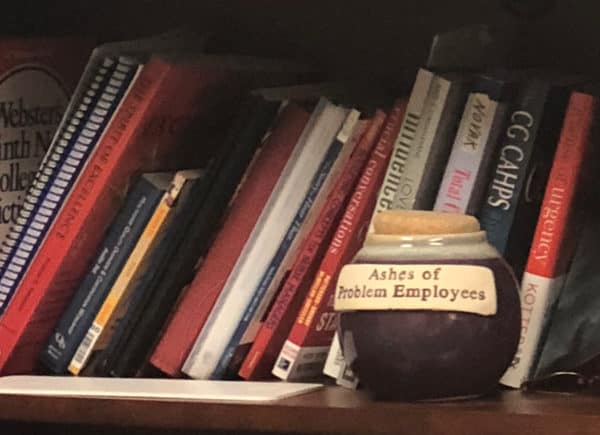We talk (and I write) a lot about workplace culture. I talk about desiring and working toward a certain type of workplace culture, where the term “Lean Culture” might apply.
There are different ways to define the phrase “workplace culture,” such as:
“It's the way we do things around here.”
But it's not just doing, it's also about thinking. What is “our way”?? What drives our “doing”?
One more formal definition of culture is:
“… a collection of attitudes, beliefs, and behaviors that make up the regular atmosphere in a work environment.”
Attitudes and beliefs can drive behaviors. Systems (or the lack thereof) can also drive behaviors.
The legendary Edgar H. Schein defines culture as:
A pattern of shared basic assumptions learned by a group as it solved its problems of external adaptation and internal integration (…) A product of joint learning.
How can we really know what a workplace's culture is like without spending a fair amount of time in the middle of it?
Can We See Culture?
You can see what people are doing and how they are doing it. But you have to talk with them to understand the underpinnings. Why are they doing things? Why are they doing things that way? What assumptions, mindsets, and thinking exist — and how consistent are those things?
Sometimes an object — an “artifact” — that exists in a workplace tells us something.
What an artifact tells us might be in the eye of the beholder. What it says to me might not be the same message that you'd guest.
And the artifacts may or may not be sending the message that's intended by the person who put the artifact in place (and those who allow it to exist). Maybe they weren't thinking or intending much of anything.
What Greeted Me at the Doctor's Office Check-In Desk?
This morning, I had an initial visit with a new primary care provider in the locale where my wife is now working (and where we are spending most of our time, outside of Texas).
My biggest concern walking in was if my medical records had been sent (by mail or some other format) from my old physician, as I had posted about on LinkedIn recently.
I reached the front desk, arriving 15 minutes before my appointment as I had been asked to do. Thankfully, I didn't have to fill out a lot of paper forms, since I had filled out a lot of information for the new provider online, as requested.
I was asked just a few questions, and I was ready to go sit over in the waiting room.
While waiting for the front desk employee to do her thing with my insurance card and driver's license, I couldn't help but notice this right near my field of vision:

It reads:
“You Can Agree With Me Or You Can Be Wrong”
Um, what?
At least the date is correct.
This isn't exactly the friendliest way to welcome somebody to their office — on a first visit or any repeat visit.
Is that telling me I should expect the front desk person to have a bad attitude? And is the artifact telling me that clinic leaders think that attitude is OK?
What does that little statue tell you about the culture there? What does it say about the workplace culture? What does it say about the customer service culture? Or lack thereof?
You might be thinking that I should relax and lighten up.
I shared this photo on LinkedIn, and one clinic manager agreed with me that this statue wasn't ideal.
Argh. As someone who lead Primary Care clinics- this is NOT OKAY.
I replied, “I agree. I wonder if the clinic leaders at different levels approve of this… or if they just don't notice?”
The clinic leader said:
I suspect they are “picking their battles” – but this is one I would pick. And I can't imagine ANY leader being okay with this- I would even say something to a peer supervisor if I saw this while visiting their clinic.
Ironically, the front desk employee who was helping me and the physician (one of many working there) were incredibly nice, beyond pleasant.
So, I'm guessing they had nothing to do with placing that statue. But have they noticed it? Have they thought about it?
Speaking of “Picking My Battles”
I didn't say or ask anything about it to either of them… I guess I figured there was no point. Maybe I'll ask, next time, “What do you mean by that little statue there??”
What I saw this morning reminded me of something I saw YEARS ago and I don't think I've shared it, nor have I written about it.
I was working with a large integrated health system. One day I was asked to go have a meeting with a Vice President of Nursing at the main hospital.
As I typically do, I arrived a few minutes early. The VP wasn't there.
The meeting time arrived, but the VP wasn't there. It was at least 10 minutes past the meeting time, no VP.
It might not surprise you that she wasn't there on time, as that's a pretty common culture in healthcare — a culture of always being behind schedule with meetings (and that's a fixable problem if you care to fix it).
I had never met this VP. Her office door was wide open. There was no admin or outer office. I wasn't trying to snoop, but I always like to see what books people are reading (or, sometimes, more accurately — the books that are on display on the shelves).
I was dumbfounded when I saw this little crock, sort of like a “swear jar” on one of her shelves:

I think this was more of a “WTF?” reaction that I had.
In case you're having trouble reading that:

It says, as an integral part of this crock (meaning it came that way):
“Ashes of Problem Employees”
Holy crap, now THAT is an artifact that sends a very loud message.
I didn't get to ask this VP what message was intended.
She never showed up for the meeting.
I gave up after about 30 minutes, as I was now feeling disrespected and I had other things to do.
But think of the disrespect that was on display toward her employees!!!
I Had Questions Though
I wondered if she had bought this for herself or if it was some sort of gift (you can actually buy this on Amazon — and there are, sadly, many varieties).
There's also, unfortunately, an “Ashes of Problem Patients” crock — and maybe I should buy that as an anonymous gift for my new doctor's office?
I didn't seek out another meeting with the nursing VP. I wasn't asked (nor did I ever receive an apology for the “no show” after I had sent an email asking about what happened, in case I had the time wrong on my calendar).
I drew all sorts of conclusions. I assumed she wasn't a nice person and guessed that she wasn't a good leader. I wasn't there to coach her (she wasn't inviting that), so I let it go.
But I haven't forgotten it.
Should I have asked something open-ended, like:
“Hmmm… I bet there's a story behind that crock there??”
Did she think it was funny? Was it a form of “gallows humor” for a challenging healthcare environment?
Wait, isn't this supposed to be a “caring” profession and a “caring environment”?
How did this VP react to employees who had complaints and/or ideas? What made somebody a “problem employee”?
And why would one think about murdering them and burning them down to ashes? OK, I'm taking that too literally. But still…
Is this a culture with any degree of “psychological safety” that would allow people to safely speak up about anything?
I got away from this client as soon as I could. It was a very toxic environment, and the CEO was a bully who, unfortunately, set the tone and created a culture of fear.
It was never likely to be a “Lean Culture,” regardless of who was helping them or how much help they wanted. They could do projects… and I aim to do more than just projects at this stage in my life and career.
Who I associate with and who I spend time with matters to me. I don't think those “leaders” shared my values. It wasn't a good fit. Thankfully, not being an employee made it much easier to walk away.
Their loss.
Or mine.
Or both?
Should I have spoken up? Would it have done any good? Or was I right to just cut and run, to live another day — someplace else and happier?
What do you think? Leave a comment below…
Please scroll down (or click) to post a comment. Connect with me on LinkedIn.
Let’s build a culture of continuous improvement and psychological safety—together. If you're a leader aiming for lasting change (not just more projects), I help organizations:
- Engage people at all levels in sustainable improvement
- Shift from fear of mistakes to learning from them
- Apply Lean thinking in practical, people-centered ways
Interested in coaching or a keynote talk? Let’s talk.
Join me for a Lean Healthcare Accelerator Trip to Japan! Learn More










Great observations!
Artefacts communicate culture – to insiders and to visitors.
I wonder if they also create culture – if I see that statuette at reception I will be bracing myself for an argument and that might be enough to get one started.
Yeah, I understand. I just rolled my eyes at it…
I was reminded of something I saw at my very first job. First day at work, we went to the coffee room for a break and on the bulletin board was a poem. I don’t recall the exact words, but the message this: If you think you’re important here, just stick your hand in a bucket of water. When you pull your hand out, the hole in the water is the hole you’ll leave when you quit. I was horrified. What had I got myself into? Fortunately, the boss wasn’t that way, but I’ve never forgotten the terrible message that left for us workers. Sadly, I’ve worked at many places where that attitude is entrenched. The little or subtle messages matter.
That’s awful!
Comments are closed.